You’ve probably heard it a hundred times — “Brown sugar is the healthier alternative to white sugar.” But is that really true, or is it just clever marketing wrapped in a caramel-colored disguise? Let’s separate myth from science.

1. What Exactly Is Brown Sugar?
Contrary to popular belief, brown sugar is not an unrefined natural sweetener. It’s typically refined white sugar with molasses added back — giving it that moist texture, darker color, and slightly richer taste.
According to the U.S. Department of Agriculture (USDA, 2023), standard brown sugar contains about 3.5–6.5% molasses by weight. The more molasses it contains, the darker its color and the stronger its flavor.
So, from a manufacturing standpoint, brown sugar isn’t “less processed” — it’s just white sugar re-dressed.
2. Nutrient Comparison: Brown vs. White Sugar
Molasses does add trace minerals like calcium, potassium, magnesium, and iron to brown sugar — but only in minute amounts. For example:
| Nutrient (per 100g) | White Sugar | Brown Sugar |
| Calories | 387 kcal | 380 kcal |
| Calcium | 1 mg | 85 mg |
| Potassium | 2 mg | 133 mg |
| Iron | 0.1 mg | 0.7 mg |
(Source: USDA FoodData Central, 2023)
While brown sugar has slightly more nutrients, you’d need to consume cups of it to make any real nutritional difference — and that would far exceed safe sugar intake levels.
3. Calories & Glycemic Index — Nearly Identical
Both white and brown sugar deliver about 15–16 calories per teaspoon. Their glycemic index (GI) — the measure of how fast a food raises blood sugar — is also nearly identical:
- White sugar: GI ≈ 65
- Brown sugar: GI ≈ 64
This means your body processes them almost exactly the same way — breaking them down into glucose and fructose, leading to similar spikes in blood sugar and insulin.
4. The Flavor Factor (Not the Health Factor)
Where brown sugar does win is flavor. Thanks to molasses, it offers a deeper, caramel-like taste and higher moisture content — perfect for cookies, barbecue sauces, and baked goods. But this is a culinary advantage, not a nutritional one.
If your recipe benefits from that warm, earthy flavor — go ahead and use brown sugar. Just don’t expect your body to treat it any differently from white sugar.
5. The Real Health Problem: Added Sugars in General
The World Health Organization (WHO, 2022) recommends limiting added sugars (including both brown and white) to less than 10% of total daily calories, and ideally below 5% for optimal health. Excess added sugars are linked to:
- Increased risk of obesity and type 2 diabetes
- Fatty liver disease
- Heart disease and chronic inflammation
So, whether your sugar is golden brown or sparkling white, the key to health is moderation, not color.
6. Healthier Sweetener Alternatives
If you’re seeking genuine alternatives, consider these options:
- Stevia – Zero-calorie natural sweetener from plant leaves.
- Erythritol – A sugar alcohol with a low glycemic impact.
- Raw honey – Contains antioxidants and trace nutrients, but still calorie-dense.
- Maple syrup – Offers polyphenols and a lower GI (~54) but should still be used sparingly.
Brands like Wholesome Sweeteners and Madhava produce organic brown and raw cane sugars, which are less refined but still not “healthy” in excess.
7. Bottom Line Brown sugar may look rustic and natural, but in reality, it’s nutritionally almost identical to white sugar. The difference is in taste and texture, not health. If you’re watching your sugar intake, don’t be fooled by color — the body sees all added sugars the same way.
Leave a Reply